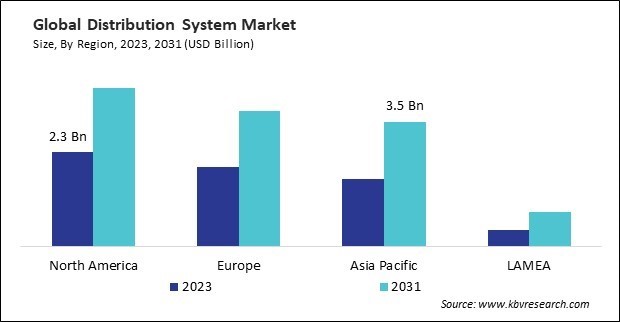According to a new report, published by KBV research, The Global Distribution System Market size is expected to reach $11.8 billion by 2031, rising at a market growth of 7.5% CAGR during the forecast period.
Distribution systems use machine learning algorithms, artificial intelligence (AI), and data analytics to optimize distribution tactics, predict demand trends, and provide actionable insights into supply chain operations. Predictive analytics enable businesses to forecast demand, optimize inventory levels, and proactively identify potential supply chain disruptions, enabling more informed decision-making and risk mitigation. Similarly, the rise of on-demand logistics services, fueled by the gig economy and changing consumer expectations, drives the need for agile and flexible distribution systems to support rapid order fulfillment, same-day delivery, and dynamic routing.

Distribution systems are incorporating on-demand capabilities, such as crowd-sourced delivery, micro-fulfillment centers, and dynamic routing algorithms, to meet the demand for fast, convenient, and flexible logistics solutions. Innovations in the distribution system market are revolutionizing how businesses manage supply chain operations, optimize inventory, and deliver products to customers. For instance, predictive analytics technologies revolutionize distribution systems by providing insights into future demand patterns, inventory trends, and supply chain risks.
Drones and autonomous cars are revolutionizing last-mile delivery services for distribution networks. Self-driving trucks, delivery robots, and unmanned aerial vehicles (UAVs) enable businesses to automate delivery processes, reduce delivery times, and lower transportation costs. These technologies enhance efficiency, safety, and sustainability in urban logistics and remote delivery locations. Cloud-based distribution platforms are transforming the scalability, agility, and accessibility of distribution systems.
The distribution system market is experiencing rapid expansion driven by globalization, e-commerce growth, technological advancements, and evolving consumer preferences. With the increasing interconnectedness of globally, companies are expanding their distribution networks to reach new customers and capitalize on emerging opportunities. Additionally, the rise of e-commerce has transformed distribution systems, leading to the proliferation of fulfillment centers, last-mile delivery solutions, and digital platforms to meet the growing demand for online shopping.
The Software segment is generating highest revenue in the Global Distribution System Market, By Component in 2023; thereby, achieving a market value of $7.3 Billion by 2031. Software solutions offer automation capabilities that streamline distribution processes, enhance efficiency, and reduce manual labor. These solutions save companies in the distribution industry a lot of time and money by automating processes including order processing, inventory control, warehouse management, and transportation logistics.
The Aviation segment is experiencing a CAGR of 7.9% during (2024 - 2031). The aviation industry operates globally, with various countries’ manufacturers, suppliers, and maintenance facilities. Managing the supply chain for aircraft components, spare parts, and maintenance materials requires sophisticated distribution systems to ensure timely delivery and maintenance of aircraft. Distribution systems play a critical role in managing the movement of aviation-related goods, coordinating logistics activities, and ensuring compliance with regulatory requirements.
Full Report: https://www.kbvresearch.com/distribution-system-market/
The North America region dominated the Global Distribution System Market, By Region in 2023, and would continue to be a dominant market till 2031; thereby, achieving a market value of $4.1 Billion by 2031. The Europe region is anticipated to grow at a CAGR of 7.1% during (2024 - 2031). Additionally, The Asia Pacific region would witness a CAGR of 8.1% during (2024 - 2031).
By Component
By Application
By Geography
 Unique Offerings
Unique Offerings